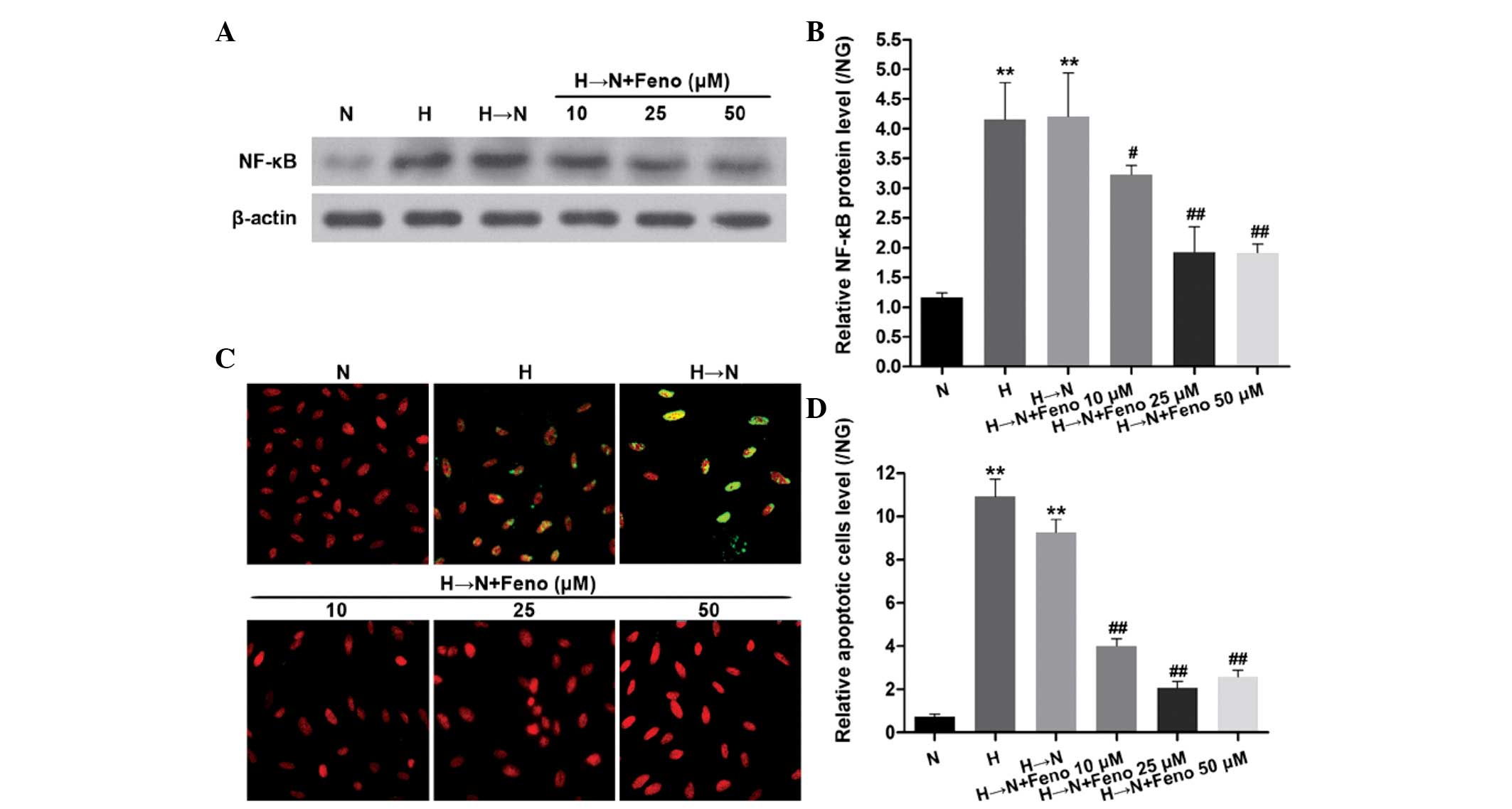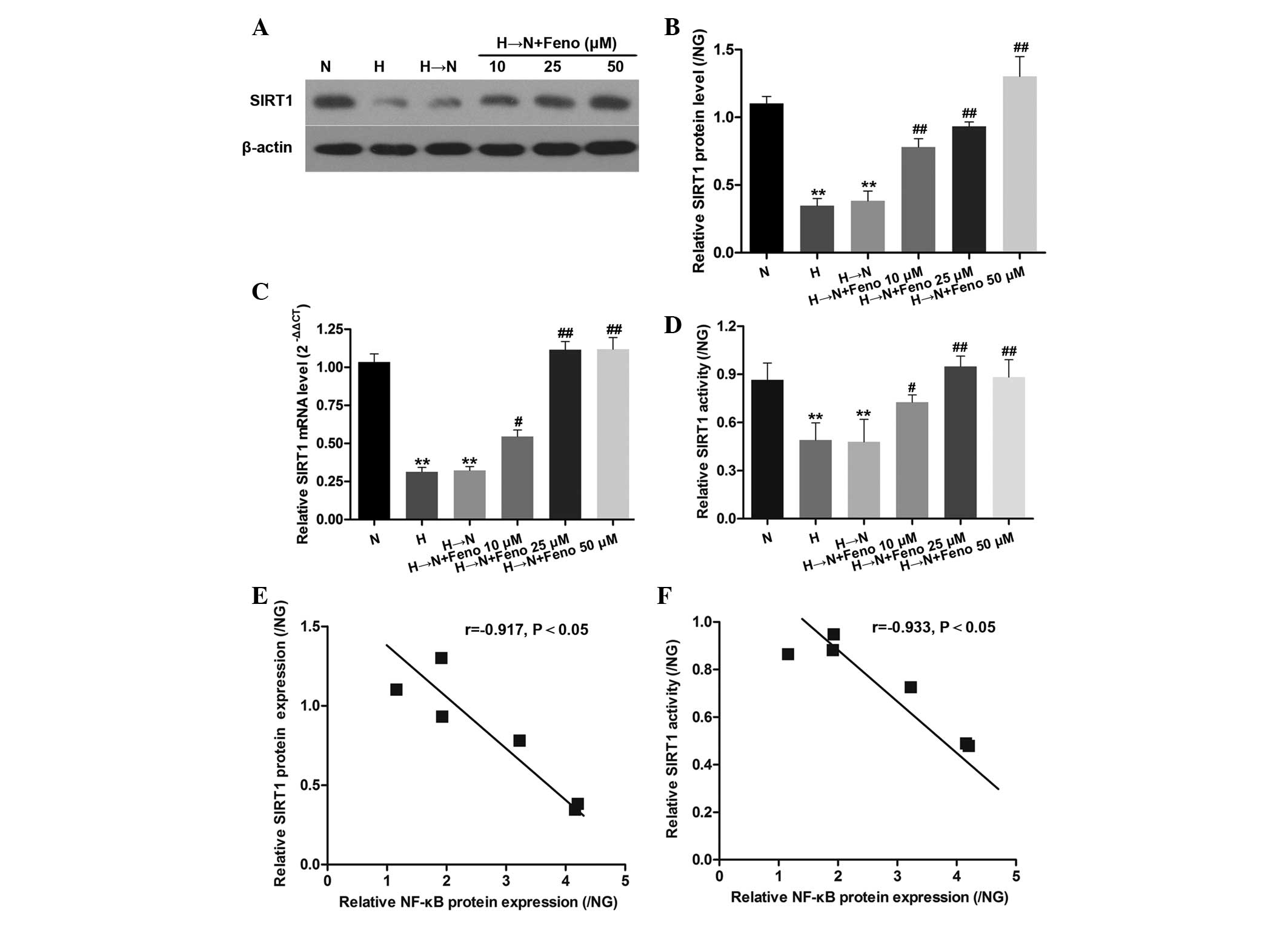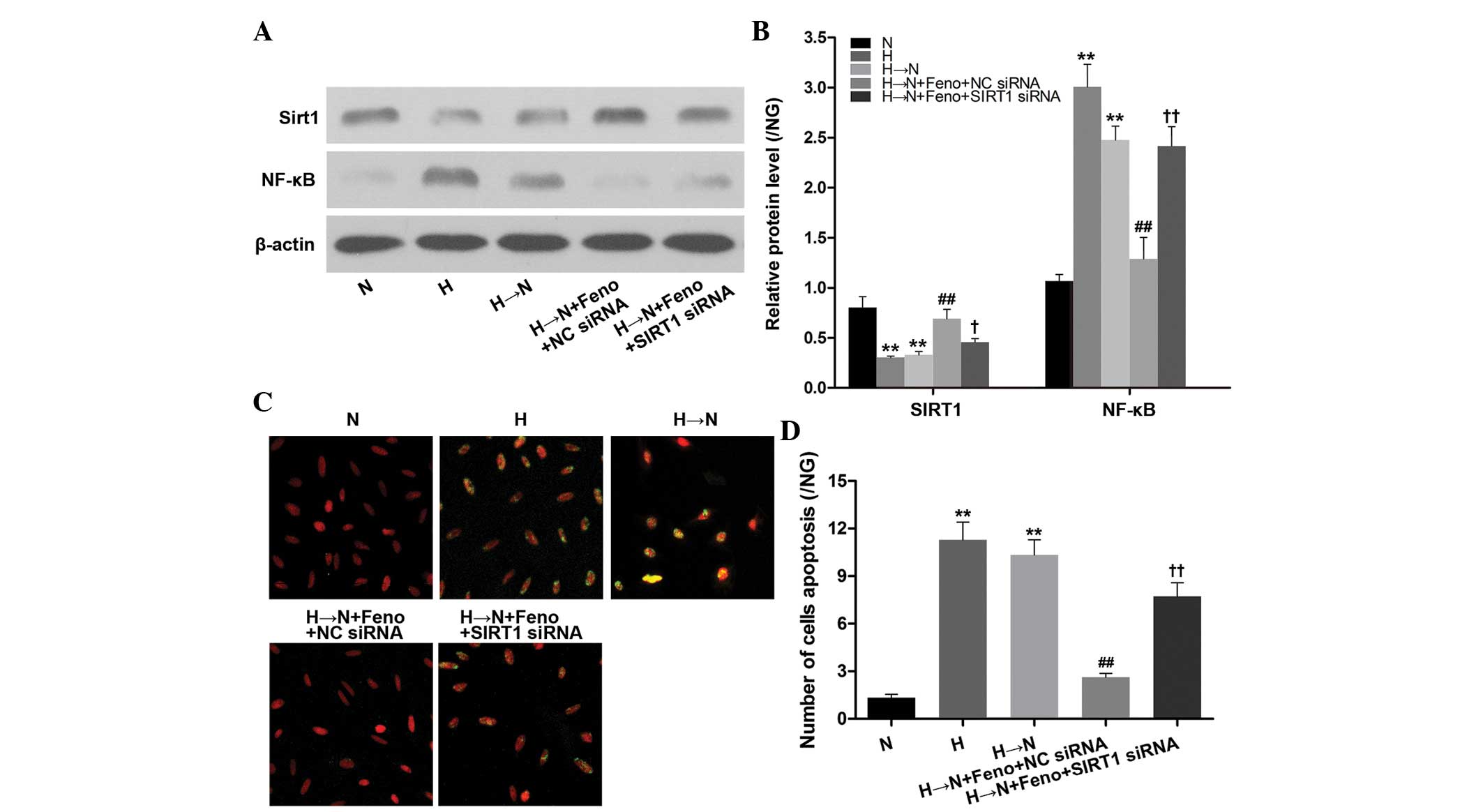|
1
|
Lutty GA: Effects of diabetes on the eye.
Invest Ophthalmol Vis Sci. 54:ORSF81–87. 2013. View Article : Google Scholar : PubMed/NCBI
|
|
2
|
No authors listed. Retinopathy and
nephropathy in patients with type 1 diabetes four years after a
trial of intensive therapy. The Diabetes Control and Complications
Trial/Epidemiology of Diabetes Interventions and Complications
Research Group. N Engl J Med. 342:381–389. 2000. View Article : Google Scholar : PubMed/NCBI
|
|
3
|
Writing Team for the Diabetes Control and
Complications Trial/Epidemiology of Diabetes Interventions and
Complications Research Group: Effect of intensive therapy on the
microvascular complications of type 1 diabetes mellitus. JAMA.
287:2563–2569. 2002. View Article : Google Scholar : PubMed/NCBI
|
|
4
|
Ceriello A, Ihnat MA and Thorpe JE:
Clinical review 2: The 'metabolic memory': is more than just tight
glucose control necessary to prevent diabetic complications? J Clin
Endocrinol Metab. 94:410–415. 2009. View Article : Google Scholar
|
|
5
|
Zheng Z, Chen H, Li J, Li T, Zheng B,
Zheng Y, Jin H, He Y, Gu Q and Xu X: Sirtuin 1-mediated cellular
metabolic memory of high glucose via the LKB1/AMPK/ROS pathway and
therapeutic effects of metformin. Diabetes. 61:217–228. 2012.
View Article : Google Scholar :
|
|
6
|
Kowluru RA and Chan PS: Metabolic memory
in diabetes - from in vitro oddity to in vivo problem: Role of
apoptosis. Brain Res Bull. 81:297–302. 2010. View Article : Google Scholar
|
|
7
|
Kowluru RA, Chakrabarti S and Chen S:
Re-institution of good metabolic control in diabetic rats and
activation of caspase-3 and nuclear transcriptional factor
(NF-kappaB) in the retina. Acta Diabetol. 41:194–199. 2004.
View Article : Google Scholar
|
|
8
|
Kowluru RA, Zhong Q and Kanwar M:
Metabolic memory and diabetic retinopathy: Role of inflammatory
mediators in retinal pericytes. Exp Eye Res. 90:617–623. 2010.
View Article : Google Scholar : PubMed/NCBI
|
|
9
|
Sen R and Baltimore D: Inducibility of
kappa immunoglobulin enhancer-binding protein Nf-kappa B by a
posttranslational mechanism. Cell. 47:921–928. 1986. View Article : Google Scholar : PubMed/NCBI
|
|
10
|
Oeckinghaus A and Ghosh S: The NF-kappaB
family of transcription factors and its regulation. Cold Spring
Harb Perspect Biol. 1:a0000342009. View Article : Google Scholar
|
|
11
|
DiDonato JA, Mercurio F and Karin M:
NF-kappaB and the link between inflammation and cancer. Immunol
Rev. 246:379–400. 2012. View Article : Google Scholar : PubMed/NCBI
|
|
12
|
Kowluru RA, Koppolu P, Chakrabarti S and
Chen S: Diabetes-induced activation of nuclear transcriptional
factor in the retina and its inhibition by antioxidants. Free Radic
Res. 37:1169–1180. 2003. View Article : Google Scholar
|
|
13
|
Yu J and Auwerx J: Protein deacetylation
by SIRT1: An emerging key post-translational modification in
metabolic regulation. Pharmacol Res. 62:35–41. 2010. View Article : Google Scholar
|
|
14
|
Haigis MC and Sinclair DA: Mammalian
sirtuins: Biological insights and disease relevance. Annu Rev
Pathol. 5:253–295. 2010. View Article : Google Scholar : PubMed/NCBI
|
|
15
|
Baur JA: Resveratrol, sirtuins and the
promise of a DR mimetic. Mech Ageing Dev. 131:261–269. 2010.
View Article : Google Scholar : PubMed/NCBI
|
|
16
|
Cai W, Ramdas M, Zhu L, Chen X, Striker GE
and Vlassara H: Oral advanced glycation endproducts (AGEs) promote
insulin resistance and diabetes by depleting the antioxidant
defenses AGE receptor-1 and sirtuin 1. Proc Natl Acad Sci USA.
109:15888–15893. 2012. View Article : Google Scholar : PubMed/NCBI
|
|
17
|
Tsai KL, Huang PH, Kao CL, Leu HB, Cheng
YH, Liao YW, Yang YP, Chien Y, Wang CY, Hsiao CY, et al: Aspirin
attenuates vinorelbine-induced endothelial inflammation via
modulating SIRT1/AMPK axis. Biochem Pharmacol. 88:189–200. 2014.
View Article : Google Scholar
|
|
18
|
Kim ES, Isoda F, Kurland I and Mobbs CV:
Glucose-induced metabolic memory in Schwann cells: prevention by
PPAR agonists. Endocrinology. 154:3054–3066. 2013. View Article : Google Scholar : PubMed/NCBI
|
|
19
|
Wang W, Bai L, Qiao H, Lu Y, Yang L, Zhang
J, Lin R, Ren F, Zhang J and Ji M: The protective effect of
fenofibrate against TNF-α-induced CD40 expression through
SIRT1-mediated deacetylation of NF-κB in endothelial cells.
Inflammation. 37:177–185. 2014. View Article : Google Scholar
|
|
20
|
Wang W, Lin Q, Lin R, Zhang J, Ren F,
Zhang J, Ji M and Li Y: PPARalpha agonist fenofibrate attenuates
TNF-α-induced CD40 expression in 3T3-L1 adipocytes via the
SIRT1-dependent signaling pathway. Exp Cell Res. 319:1523–1533.
2013. View Article : Google Scholar : PubMed/NCBI
|
|
21
|
Livak KJ and Schmittgen TD: Analysis of
relative gene expression data using real-time quantitative PCR and
the 2(-Delta Delta C(T)) Method. Methods. 25:402–408. 2001.
View Article : Google Scholar
|
|
22
|
No authors listed. The effect of intensive
diabetes therapy on the development and progression of neuropathy.
The Diabetes Control and Complications Trial Research Group. Ann
Intern Med. 122:561–568. 1995. View Article : Google Scholar : PubMed/NCBI
|
|
23
|
Writing Team for the Diabetes Control and
Complications Trial/Epidemiology of Diabetes Interventions and
Complications Research Group: Sustained effect of intensive
treatment of type 1 diabetes mellitus on development and
progression of diabetic nephropathy: the Epidemiology of Diabetes
Interventions and Complications (EDIC) study. JAMA. 290:2159–2167.
2003. View Article : Google Scholar : PubMed/NCBI
|
|
24
|
Ihnat MA, Thorpe JE and Ceriello A:
Hypothesis: The 'metabolic memory', the new challenge of diabetes.
Diabet Med. 24:582–586. 2007. View Article : Google Scholar : PubMed/NCBI
|
|
25
|
LeRoith D, Fonseca V and Vinik A:
Metabolic memory in diabetes-focus on insulin. Diabetes Metab Res
Rev. 21:85–90. 2005. View
Article : Google Scholar
|
|
26
|
Baker RG, Hayden MS and Ghosh S: NF-κB,
inflammation and metabolic disease. Cell Metab. 13:11–22. 2011.
View Article : Google Scholar : PubMed/NCBI
|
|
27
|
Salminen A, Kauppinen A, Suuronen T and
Kaarniranta K: SIRT1 longevity factor suppresses NF-kappaB-driven
immune responses: Regulation of aging via NF-kappaB acetylation?
Bioessays. 30:939–942. 2008. View Article : Google Scholar : PubMed/NCBI
|
|
28
|
Yao H and Rahman I: Perspectives on
translational and therapeutic aspects of SIRT1 in inflammaging and
senescence. Biochem Pharmacol. 84:1332–1339. 2012. View Article : Google Scholar : PubMed/NCBI
|
|
29
|
Xie J, Zhang X and Zhang L: Negative
regulation of inflammation by SIRT1. Pharmacol Res. 67:60–67. 2013.
View Article : Google Scholar
|
|
30
|
Keech AC, Mitchell P, Summanen PA, O'Day
J, Davis TM, Moffitt MS, Taskinen MR, Simes RJ, Tse D, Williamson
E, et al: Effect of fenofibrate on the need for laser treatment for
diabetic retinopathy (FIELD study): A randomised controlled trial.
Lancet. 370:1687–1697. 2007. View Article : Google Scholar : PubMed/NCBI
|
|
31
|
Ginsberg HN, Elam MB, Lovato LC III,
Crouse JR III, Leiter LA, Linz P, Friedewald WT, Buse JB, Gerstein
HC, Probstfield J, et al: Effects of combination lipid therapy in
type 2 diabetes mellitus. N Engl J Med. 362:1563–1574. 2010.
View Article : Google Scholar : PubMed/NCBI
|
|
32
|
Planavila A, Iglesias R, Giralt M and
Villarroya F: Sirt1 acts in association with PPARalpha to protect
the heart from hypertrophy, metabolic dysregulation and
inflammation. Cardiovasc Res. 90:276–284. 2011. View Article : Google Scholar
|
|
33
|
Biscetti F, Gaetani E, Flex A, Aprahamian
T, Hopkins T, Straface G, Pecorini G, Stigliano E, Smith RC,
Angelini F, et al: Selective activation of peroxisome
proliferator-activated receptor (PPAR)alpha and PPAR gamma induces
neoangiogenesis through a vascular endothelial growth
factor-dependent mechanism. Diabetes. 57:1394–1404. 2008.
View Article : Google Scholar : PubMed/NCBI
|
|
34
|
Okayasu T, Tomizawa A, Suzuki K, Manaka K
and Hattori Y: PPARalpha activators upregulate eNOS activity and
inhibit cytokine-induced NF-kappaB activation through AMP-activated
protein kinase activation. Life Sci. 82:884–891. 2008. View Article : Google Scholar : PubMed/NCBI
|
|
35
|
Shen W, Gao Y, Lu B, Zhang Q, Hu Y and
Chen Y: Negatively regulating TLR4/NF-kappaB signaling via PPARα in
endotoxin-induced uveitis. Biochim Biophys Acta. 1842:1109–1120.
2014. View Article : Google Scholar : PubMed/NCBI
|













